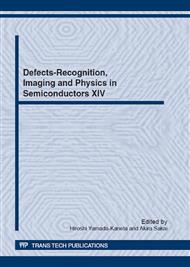p.243
p.247
p.251
p.255
p.261
p.265
p.269
p.273
p.277
Electron-Beam-Induced Current Study of Electronic Property Change at SrTiO3 Bicrystal Interface Induced by Forming Process
Abstract:
We investigated the spatial variation of energy band structure in a SrTiO3 (001) bicrystal with the (100) 10° tilt boundary before and after the annealing process at 973 K under a vacuum of ~10-7 Torr and after the subsequent forming process with electrical dielectric breakdown, using electron beam induced current (EBIC) method in the temperature range between 200 and 300K. Although the EBIC contrast at the tilt boundary was weak before and after the annealing, it became visible after the forming process and stronger as the observation temperature decreased to less than 260 K. It was found that the EBIC direction at the tilt boundary is opposite to that in the matrix, i.e. the single crystalline regions of both sides of the tilt boundary. In the matrix, the EBIC increased after the annealing and decreased again after the forming process. We propose energy band structures of the bicrystalline SrTiO3 after the annealing and after the forming process.
Info:
Periodical:
Pages:
261-264
Citation:
Online since:
July 2012
Authors:
Price:
Сopyright:
© 2012 Trans Tech Publications Ltd. All Rights Reserved
Share:
Citation:


